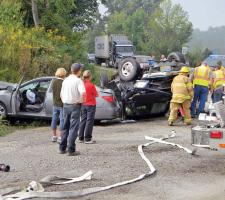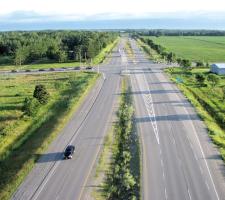
David Crawford takes a look at innovations to reduce crashes at rural intersections.
Intersection crashes continue to represent a worryingly large share of deaths and serious injuries across US highway networks. Statistics from the US Department of Transportation’s
Rural STOP (static-only) sign-controlled intersections are accident blackspots across the country. A NHTSA study found that in crashes at these intersections, 62% of the drivers involved had stopped to look before proceeding but did not see the vehicle that was approaching on the main route. A further 20% misjudged the gap that this vehicle was leaving; 14% had an obstructed view of the other vehicle; and 4% were the victims of ice-covered roads. In one sample, 90% even failed to see the STOP sign.
In the past, US highways agencies have relied in tackling the issue largely on physical measures, such as better intersection lighting, enhanced static signing and geometric improvements to road layouts. The growing adoption of ITS-based solutions is a relatively recent response to the toll of deaths and serious injuries that continues in spite of these measures, with injuries in rural areas more likely to result in death than those incurred in an urban context.
One of the main reasons is that rural crashes are more likely to occur at higher speeds as lower traffic levels and fewer intersections mean drivers are more comfortable travelling at speed, so the damage resulting from a collision is therefore greater. The rural victims of the fatal crashes are also more likely than their urban-driving counterparts to be unbelted which in 17 states is only an offence when combined with another traffic violation.
Additionally it may take first responders longer to arrive at rural crash sites, meaning casualties wait longer for medical attention. Finally, patients’ needs may exceed the capabilities of conveniently accessible rural health care setups.
The wellspring of current activity is the FHWA’s 1991 intersection conflict warning system (ICWS) project, which introduced the concept of a dual assembly of traffic-actuated warning signs linked to pavement loops and a traffic signal controller. Claimed by the administration as a ‘first-of its-kind, anywhere’, this led to the December 2011 issue of its Design and Evaluation Guidance, produced under the US Enterprise programme.
The underlying principle is that drivers approaching on a major through road receive a warning when a vehicle is preparing to enter an intersection from the cross street. At the same time, drivers waiting at STOP signs on the minor approach see a ‘crossing traffic’ sign when vehicles are approaching along the major route. Overall, results to date have shown reductions in fatal crashes and serious injuries by 30% and 80% respectively.
The thinking behind the scheme responds to the fact that, while safety at unsignalised intersections remains a major national concern, a fully-equipped crossing can be hard to justify, particularly in rural areas, not least due to the costs of installation and maintenance. Apart from these, there is also evidence that traffic signals are not necessarily the best way of reducing crashes.
A November 2012 report for the North Carolina Department of Transportation (NCDOT) cites two main reasons. The first of these was that when mainline traffic is forced to stop under high-speed, low-volume conditions, numbers of rear-end crashes may increase. Secondly, while signals can reduce delays on the lower-volume roads, they can increase delays on the mainline ones carrying greater traffic volumes.
Minnesota’s experience supports this conclusion.
There is also concern about another type of intervention, the use of continuously flashing signs at STOP-controlled intersections, designed to heighten driver awareness generally. These, say NCDOT, fail to address the crucial issue of traffic gap-acceptance (as highlighted by NHTSA) and can therefore deliver only modest safety improvements.
Its report stresses that motorists entering two-way, unsignalised controlled intersections - having previously stopped at a static sign - have to make “complex decisions” on the speed and direction of approaching vehicles. In response, US states including Minnesota and North Carolina are actively engaged in developing ITS-based solutions that do not depend on the use of traffic signals and are researching the issue in greater depth.
Speaking at the November 2014 Toward Zero Deaths conference staged by Minnesota Department of Transportation (MnDOT), safety planning engineer Derek Leuer highlighted the vulnerability of older drivers (45% of all victims in the state). He also highlighted the higher incidence of crashes in the further lanes of through routes, involving vehicles that have already reached the median and an apparently increased risks for drivers on minor roads where traffic volumes are between 500 and 1,500 vehicles per day.
However, he concluded by calling for greater focus on the risks generated by heavy commercial trucks.
MnDOT is now well into a 2012-2015 Rural ICWS project designed to cover up to 50 intersections, using technologies including GTT’s Canoga vehicle sensing which has delivered accuracy levels of up to 99.997%. The DOT’s solar-powered ALERT system combines detection, wireless communication and flashing LEDs to warn drivers on both major and minor roads.
Early results from a pilot installation in the city of Duluth showed that when signs were flashing, speeds on the major road decreased, drivers on the minor road waited longer, and minor road roll-throughs (when a driver treats a STOP sign as merely a YIELD sign) ceased. However, a major unintended consequence was that drivers on the minor road came to depend completely on the ALERT warning.
They ignored the STOP sign; so that, when there was no flashing sign, they went on over and increased levels of roll throughs. The issue is under scrutiny in the ALERT-2 phase.
Minnesota’s efforts have been acknowledged at national level. In 2013, the White House named state traffic engineer and TZD programme co-chair Sue Groth as a transportation ‘champion of change’ for MnDOT’s work on intersection safety.
The state’s targets for 2020 are fewer than 300 road traffic accident deaths per year and fewer than 850 cases of serious injury (compared with 387 and 1213 respectively in 2013).
Flashing
In a parallel initiative, NCDOT has now deployed some 80 ‘vehicle entering when flashing’ conflict warning systems at stop-controlled intersections. These are typically sited where frontal impact crash patterns can be traced to poor gap acceptance and/or issues of sight distance (the length of a road surface which a particular driver can see with adequate clearness).
The stopped motorist still has to judge the gaps in traffic and the point at which it is safe to proceed. NCDOT says, however, that the through motorist is made more aware of the risk.
A 2012 evaluation showed that two out of four versions trialled, one with advance post-mounted signs on the major road, another combining major- and minor-road alerts, have proved promising in reducing crashes at intersections where each road has two lanes, one in either direction.
NCDOT has also identified the need for further research to improve the effectiveness of ‘vehicle entering when flashing’ intersections including traffic volume thresholds and analysis of intersection lane geometry. Other issues requiring research include the sign sizes and messages, the potential contribution of combined messaging on both major and minor approaches to intersections. On the technical side it will look at the distance between loop detectors and the intersection, the number of loops on the minor approach (some have lead-in loops) and the variability of detector timing settings.
The DOT also looks forward, ‘in the near future’ to multiple initiatives at cross-state level, that will take a ‘more comprehensive’ look at standardisation issues.
Its list highlights the lack of common specifications for systems, which means that a number of different approaches are in use, often without specific guidance.
In response, the FHWA is pursuing an Enterprise pooled-fund programme to create a framework for the more consistent deployment and further evaluation of systems, with its Design and Evaluation Guidance as a key step.







